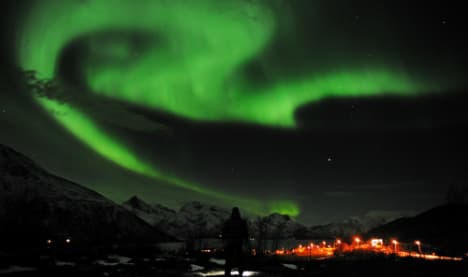High chance of Northern Lights in Sweden skies

A particularly active sun alongside clear cold nights has dramatically raised the chances of experiencing the Northern Lights in Swedish skies in 2015.
The Northern Lights, or aurora borealis, are a famous feature of Scandinavian winter nights but they can prove difficult to spot. The phenomenon has been described as nature's own disco and tourism based around the natural light show is increasing in Sweden. Winter, and the cold, dark nights that come with it, provide a generally increased chance of spotting the dancing lights on the horizon, but as the new year approaches the chances have been heightened still further by an unusually high level of solar activity. The active sun energizes and charges nuclear particles that enter and collide with atoms and molecules in the earth's atmosphere. Urban Brändström is a Northern Lights researcher at the Swedish Institute of Space Physics in Kiruna and while formally on holiday is busy keeping watch on what he describes as a particularly vibrant aurora over the city at the moment. "The probability of auroras vary primarily with the solar cycle of about 11 years, although other variations also occur," Brändström told the TT news agency. "Kiruna residents are getting a light show every night at the moment", he enthused. "Yes, the solar maximum is a kind of rule of thumb. It must be clear and dark then you should see it. Approximately once a month at Stockholm's latitude. More rarely the farther south you go," he added. The Northern Lights are most common before midnight with the most intensive part typically lasting less than ten minutes. Brandström warned that it can sometimes be difficult to distinguish weak aurora from clouds. However aurora often carry a greenish tint and change shape in a way that a cloud does not. In addition, it is possible to see stars through the aurora. The Northern Lights are not disrupted by the increasing threats posed by climate change. The energy needed to disrupt the glow is too great. "So it is way beyond what current technology can achieve," Brändström said.
Comments
See Also
The Northern Lights, or aurora borealis, are a famous feature of Scandinavian winter nights but they can prove difficult to spot.
The phenomenon has been described as nature's own disco and tourism based around the natural light show is increasing in Sweden.
Winter, and the cold, dark nights that come with it, provide a generally increased chance of spotting the dancing lights on the horizon, but as the new year approaches the chances have been heightened still further by an unusually high level of solar activity. The active sun energizes and charges nuclear particles that enter and collide with atoms and molecules in the earth's atmosphere.
Urban Brändström is a Northern Lights researcher at the Swedish Institute of Space Physics in Kiruna and while formally on holiday is busy keeping watch on what he describes as a particularly vibrant aurora over the city at the moment.
"The probability of auroras vary primarily with the solar cycle of about 11 years, although other variations also occur," Brändström told the TT news agency.
"Kiruna residents are getting a light show every night at the moment", he enthused.
"Yes, the solar maximum is a kind of rule of thumb. It must be clear and dark then you should see it. Approximately once a month at Stockholm's latitude. More rarely the farther south you go," he added.
The Northern Lights are most common before midnight with the most intensive part typically lasting less than ten minutes.
Brandström warned that it can sometimes be difficult to distinguish weak aurora from clouds. However aurora often carry a greenish tint and change shape in a way that a cloud does not. In addition, it is possible to see stars through the aurora.
The Northern Lights are not disrupted by the increasing threats posed by climate change. The energy needed to disrupt the glow is too great.
"So it is way beyond what current technology can achieve," Brändström said.
Join the conversation in our comments section below. Share your own views and experience and if you have a question or suggestion for our journalists then email us at [email protected].
Please keep comments civil, constructive and on topic – and make sure to read our terms of use before getting involved.
Please log in here to leave a comment.